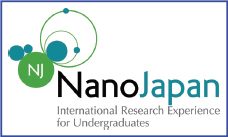NanoJapan: Connecting U.S. Undergraduates with the Best of Nanotechnology Research in Japan
Lead Institution: Rice University, Houston, TX
Collaborating Institutions: University of Tulsa, SUNY-Buffalo, University of Florida, Texas A&M University, and Southern Illinois University, Carbondale; University of Tokyo, Tokyo Institute of Technology, Keio University, RIKEN, the National Institute of Materials Science, Chiba University, Osaka University, Osaka Institute of Technology, Kyoto University, Tohoku University, Shinshu University, Hokkaido University
Category: Global/Summer Program
Date Implemented: May 2006
Website: http://nanojapan.rice.edu


Program Description: The NanoJapan: International Research Experience for Undergraduates (IREU) program focuses on cultivating interest in nanotechnology among students, especially those from underrepresented groups, and encouraging them to pursue graduate study and research in the physical sciences. This twelve-week summer program involves first and second year undergraduate science and engineering students from universities nationwide in research internships with Japanese nanoscience laboratories. While the heart of the program is the summer research experience, NanoJapan places strong emphasis on preparing students to work effectively in cross-cultural laboratory settings. Before beginning work in their research labs, students complete a three-week orientation program based in Tokyo that combines 45-hours of Japanese language instruction, an orientation to Japanese life and culture, and an introduction to nanoscale science in Japan. At the completion of the orientation, the students depart for their research labs, working for eight weeks at universities throughout Japan. At the end of the summer, the students return to Rice University to participate in a re-entry seminar and present their summer research as part of the Rice Quantum Institute (RQI) Annual Research Colloquium. Obstacles exist for U.S.-Japan collaboration, primarily linguistic and cultural barriers, and our project aims to break down these barriers by providing future generations of researchers with understanding of both the culture and the state-of-the-art technology in each country. NanoJapan also strives to foster the development of intercultural communication skills and understanding among participants and host research labs.
Anticipated and Actual Outcomes: The objectives are: a) to cultivate an interest in nanotechnology as a field of study among first and second-year students; b) to cultivate the next generation of graduate students in nanotechnology; c) to add to the skill set of active nanoscience researchers; d) to create students who are internationally savvy and have a specific interest in and knowledge of Japan; and e) to simultaneously educate students in culture, language and technology, in order that they may be more effective when addressing global scientific problems. Since 2006, 106 freshman and sophomore students representing 37 different U.S. institutions, including three community colleges, have participated. Among participants, 35% are women and 15.1% represent diverse ethnic groups. Alumni have gone on to pursue a wide range of other international opportunities including additional summer research, semester study abroad, international development and entrepreneurship programs, and graduate study. Among alumni who have graduated, 39 are pursuing STEM graduate study, one received a Hertz Fellowship, one received a Churchill Scholarship, one received an NSF East Asia Pacific Summer Fellowship to return to Japan for graduate research, and six have received NSF Graduate Research Fellowships.
Assessment Information: To assess students’ attitudes towards the engineering profession, we administer the Pittsburgh Freshman Engineering Student Attitude Assessment (PFESAA), designed to measure four facets : 1) definition of engineering; 2) attitude about engineering; 3) self‐assessed confidence; and 4) self‐assessed skills including working in groups. Language proficiency is assessed by the OPI (Oral Proficiency Interview), an American Council on the Teaching of Foreign Languages instrument that stresses students’ oral communication skills and rates students on a scale ranging from Novice‐Low to Superior. The OPI is administered as a post-program test to all students; students with prior language study also complete a pre‐test. Research has correlated gains in oral proficiency with intercultural effectiveness. Gains in intercultural learning are assessed by the Intercultural Developmental Inventory (IDI), which is taken prior to participation in the international experience, shortly after return, and within six months of return from Japan. We maintain alumni records regarding participants’ additional research or international activities, graduate school, success with scholarships and fellowships, and employment; program alumni will be required to submit an updated CV annually.
Funding/Sustainability: The annual cost for 12 students is $265,250, including staff salaries, travel, and approximately $13,795 per student. salary costs: manager: $57,500; assessment: $9,700; int’l travel expenses for faculty & staff: $32,500; student costs ($165,550): student international airfare: $22,300; airport shuttles: $500; pre-departure orientation (2 days lodging & meals): $1,850; orientation in Tokyo (3 wks): lodging: $16,500, organization & administration: $18,500, beginning language classes (45 hours): $10,500, intermediate language classes (45 hours): $9,500, intro to nanoscience seminar speakers: (20 hours): $1,500, JP Society seminar speakers (9 hours): $1,200, classroom rental fee: $2,500, cultural excursions & programming: $10,000; research internship - student housing/living stipends (8 weeks): $54,500; mid-program mtg. in Kyoto: student lodging & traditional Japanese arts workshop: $8,700; re-entry program at Rice (lodging & meals for 3 days): $4,500; assessment: language: $1,500, intercultural: $1,500.

